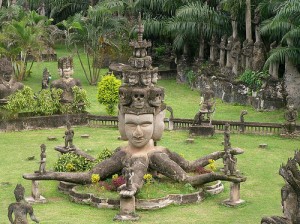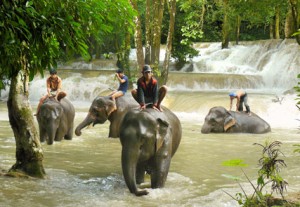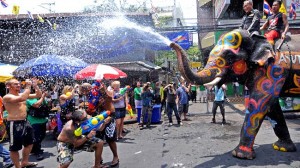 Laos is one of Southeast Asia’s least developed and least populated countries. The mighty Mekong River is at its heart, and flows through most of the major towns and cities you will visit. A strong Buddhist culture pervades, and the sight of glittering golden temples and monks collecting alms add to the country’s beauty, serenity and undeniable allure.Tourism in Laos is somewhat developed and there are luxury lodgings and wonderful eateries, yet patience is still required and the pace or style of service may be different to what you are used to. It is important to remain calm in any dealings with Lao people, as displays of anger are rare and frowned upon in Lao culture. If you have already booked your trip to Laos click here to download our pre-departure guide.
Laos is one of Southeast Asia’s least developed and least populated countries. The mighty Mekong River is at its heart, and flows through most of the major towns and cities you will visit. A strong Buddhist culture pervades, and the sight of glittering golden temples and monks collecting alms add to the country’s beauty, serenity and undeniable allure.Tourism in Laos is somewhat developed and there are luxury lodgings and wonderful eateries, yet patience is still required and the pace or style of service may be different to what you are used to. It is important to remain calm in any dealings with Lao people, as displays of anger are rare and frowned upon in Lao culture. If you have already booked your trip to Laos click here to download our pre-departure guide.
CLIMATE & TIMES TO VISIT
There are two distinct seasons in Laos: the wet season (May to October) and the dry season (November to April). You can travel to Laos any time of year. The dry season is popular, but many Travel Indochina travellers prefer the wet season as there is fewer tourists. Monsoonal showers usually occur in the afternoon and rarely affect travel plans, although travelling overland in some remote areas may not be possible. March and April are the hottest months and the evenings can be quite cool in the north between November and February.
WHAT TO EXPECT
 One of the charms of Laos is that tourism here is still developing, and at a slow pace. While there are some stunning luxury accommodation options in Vientiane and Luang Prabang, and some fine restaurants, you may find that the style and speed of service is not the same as you would find in developed countries or other destinations Asia.
One of the charms of Laos is that tourism here is still developing, and at a slow pace. While there are some stunning luxury accommodation options in Vientiane and Luang Prabang, and some fine restaurants, you may find that the style and speed of service is not the same as you would find in developed countries or other destinations Asia.
It is important that you try to be patient and deal with any frustrations in a calm manner; the Laos people are warm and welcoming, but anger is not well-tolerated. Like Thailand, Laos features a strong Theravada Buddhist culture, which is central to daily life.
EVENTS
 Banks, public offices and some tourist sites will be closed on the holidays listed below. As major holidays are set according to the lunar calendar, dates change every year. Please check with our Australia-based Asia specialists for details.
Banks, public offices and some tourist sites will be closed on the holidays listed below. As major holidays are set according to the lunar calendar, dates change every year. Please check with our Australia-based Asia specialists for details.
- 1 January is international New Year’s Day.
- 8 March is International Women’s Day.
- 13-15 April, Pii Mai (Lao New Year). Taking place over three days in mid-April, Lao Pii Mai is the biggest Lao party of the year. You can expect parades, dancing, beer-drinking and lots of water – the Lao use it for washing homes and Buddha statues, and dowsing everyone from monks, to family and passers-by.
- 1 May International Labour Day.
- August/September – Luang Prabang Boat Racing Festival accommodation is limited and some sections of the old town are not accessible.
- Mid-October – A Boat Racing Festival in Vientiane. Expect some road closures and limited hotel accommodation
- November (on the first full moon), the three-day That Luang Festival occurs at the full moon of the 12th lunar month. During this time, thousands of monks gather in Vientiane for festivities.
- 2 December is National Day Commemorates the establishment of the Lao People’s Democratic Republic in 1975.
THINGS TO REMEMBER
 A formal greeting for most Lao people is the “Nop” (joining one’s hands together in a praying gesture at chin level). Handshakes are also commonly used among male friends and with foreign visitors.
A formal greeting for most Lao people is the “Nop” (joining one’s hands together in a praying gesture at chin level). Handshakes are also commonly used among male friends and with foreign visitors.- The Lao word for “hello” is “sabai dee”, say it with smile and you’ll be well received.
- The head is considered high. It is not acceptable to touch Lao people’s heads, so bear that in mind.
- Feet are low. Placing them on furniture or pointing at things or people with your feet is not acceptable.
- Personal cleanliness is valued highly in Laos. Anyone who has strong body odour tends to get disgusting looks.
- Before entering a Lao person’s home, take your shoes off and leave them outside the house or on stairs.
- In Lao homes, if the host (especially elderly person) sits on the floor you should sit there as well, don’t sit anywhere higher if you want to be seen as a respectful person.
- It is polite to gently crouch down when walking past someone who is seated, especially older people
- Stepping over someone on your path is very impolite, similarly stepping over food is disgusting and some Lao won’t eat the food that has been stepped over.
- Lao people usually serve water to guests arriving at their home, it is polite to accept it even if you don’t want to drink (you don’t have to drink it).
- In offices, never place your feet on a desk while sitting on a chair, that’s very impolite. Some foreign specialists/advisors have been thrown out doing this, so be especially careful if you come to work here.
- In a Lao gathering, keep a low profile and you’ll maximise your chances of social success in Laos.
- Dress neatly when visiting religious shrines or temples
- It is OK to wear shoes if you just walk around a temple compound, but don’t forget to remove them before entering the chapel.
- At some temples, women in pants or short skirts are required to put on a Lao skirt as another layer before entering the place. Lao skirts are usually provided or available for hire on spot (if this is required).
- Despite the heat, Lao/Laotians dress conservatively. If you don’t want to be a “black sheep” dress neatly and moderately (don’t show too much skin) or you’ll get strange looks from the locals.
- Most Lao people swim in rivers or waterfalls with at least shorts and a T-shirt. It is more polite to do this rather than walk around in swimsuits or bikinis. Also if you are in the country and have to bathe in the river in the evening, women should wear a sarong.
- You might find it hard to communicate with locals if you don’t speak Lao especially in the countryside where not many people speak English. If things don’t quite work the way you expect, remember to keep cool, don’t loose your temper or raise your voice. It won’t help, it will only make you look bad.
- Learn some basic Lao phases and practice them with the locals you meet, they will be impressed and you will be well received.

